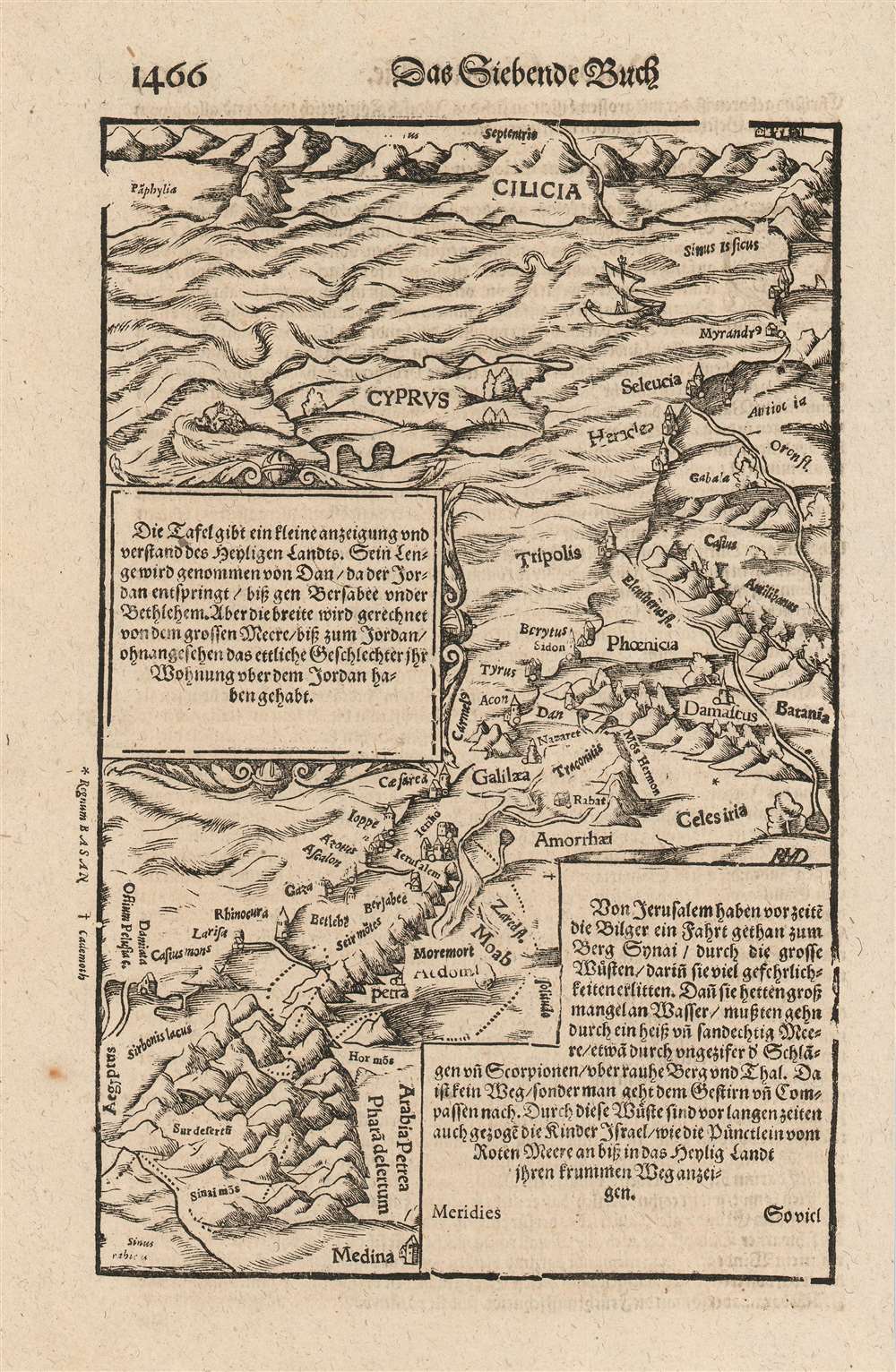1550 Münster Map of the Holy Land and Cyprus
HolyLandCyprus-munster-1550
Title
1550 (undated) 11 x 7 in (27.94 x 17.78 cm) 1 : 3500000
Description
The image first appeared in the expanded 1550 editions of Munster's Cosmographia, a work which for more than half a century provided the European literate layperson their best source of information about the world. The map's detail may have been largely drawn from Waldseemüller's Ptolemaic map of the Holy Land and the Fertile Crescent but focusing specifically on the Biblical lands and narrowing the selection of place names to reflect the Biblical era. It is interesting the Münster retains the northern orientation of the Ptolemaic Quarta Asia Tabula rather than adopting the eastern orientation of the medieval Sanuto-Vesconte, which would dominate the mapping of these lands well into the eighteenth century. That orientation allows for the inclusion of the island of Cyprus, set amongst the waves of the Mediterranean Sea. There is also a sea monster and a sailboat.
Adding to the Cosmographia
This map does not appear in Munster's work prior to 1550. Munster himself constantly labored to build the work until his death by plague in 1552, both adding to the text as well as ordering the production of improved city views and decorative woodcuts. 1550 saw the addition of this cut, along with many other maps and views to appear in the body of the work, as opposed to the 'foretext' maps that appeared from the book's inception. This woodcut was composed and possibly executed by the Swiss artist Hans Rudolf Manuel Deutsch, who produced many of Munster's woodcuts.Munster's Cosmographia was a popular work, and as many as fifty thousand were printed. While many of these did not survive, individual maps do appear on the market from time to time. The separate woodcut is listed in OCLC by only a few institutional collections, although the full work is well represented. The pagination of this specific example is consistent with the 1614 German edition of Cosmographei. While there is not a detailed taxonomy for state changes for this map, we note that after 1588 but no later than 1598 the text blocks for 'Regnū Basan' (Bashan) and 'Cademoth' went missing, and Petri replaced them with marginal text keyed with an asterisk and a cross to the appropriate locations on the map.CartographerS
Sebastian Münster (January 20, 1488 - May 26, 1552), was a German cartographer, cosmographer, Hebrew scholar and humanist. He was born at Ingelheim near Mainz, the son of Andreas Munster. He completed his studies at the Eberhard-Karls-Universität Tübingen in 1518, after which he was appointed to the University of Basel in 1527. As Professor of Hebrew, he edited the Hebrew Bible, accompanied by a Latin translation. In 1540 he published a Latin edition of Ptolemy's Geographia, which presented the ancient cartographer's 2nd century geographical data supplemented systematically with maps of the modern world. This was followed by what can be considered his principal work, the Cosmographia. First issued in 1544, this was the earliest German description of the modern world. It would become the go-to book for any literate layperson who wished to know about anywhere that was further than a day's journey from home. In preparation for his work on Cosmographia, Münster reached out to humanists around Europe and especially within the Holy Roman Empire, enlisting colleagues to provide him with up-to-date maps and views of their countries and cities, with the result that the book contains a disproportionate number of maps providing the first modern depictions of the areas they depict. Münster, as a religious man, was not producing a travel guide. Just as his work in ancient languages was intended to provide his students with as direct a connection as possible to scriptural revelation, his object in producing Cosmographia was to provide the reader with a description of all of creation: a further means of gaining revelation. The book, unsurprisingly, proved popular and was reissued in numerous editions and languages including Latin, French, Italian, and Czech. The last German edition was published in 1628, long after Münster's death of the plague in 1552. Cosmographia was one of the most successful and popular books of the 16th century, passing through 24 editions between 1544 and 1628. This success was due in part to its fascinating woodcuts (some by Hans Holbein the Younger, Urs Graf, Hans Rudolph Manuel Deutsch, and David Kandel). Münster's work was highly influential in reviving classical geography in 16th century Europe, and providing the intellectual foundations for the production of later compilations of cartographic work, such as Ortelius' Theatrum Orbis Terrarum Münster's output includes a small format 1536 map of Europe; the 1532 Grynaeus map of the world is also attributed to him. His non-geographical output includes Dictionarium trilingue in Latin, Greek, and Hebrew, and his 1537 Hebrew Gospel of Matthew. Most of Munster's work was published by his stepson, Heinrich Petri (Henricus Petrus), and his son Sebastian Henric Petri. More by this mapmaker...
Heinrich Petri (1508 - 1579) and his son Sebastian Henric Petri (1545 – 1627) were printers based in Basel, Switzerland. Heinrich was the son of the printer Adam Petri and Anna Selber. After Adam died in 1527, Anna married the humanist and geographer Sebastian Münster - one of Adam's collaborators. Sebastian contracted his stepson, Henricus Petri (Petrus), to print editions of his wildly popular Cosmographia. Later Petri, brought his son, Sebastian Henric Petri, into the family business. Their firm was known as the Officina Henricpetrina. In addition to the Cosmographia, they also published a number of other seminal works including the 1566 second edition of Nicolaus Copernicus's De Revolutionibus Orbium Coelestium and Georg Joachim Rheticus's Narratio. Learn More...
Hans Rudolf Manuel Deutsch (1525–1571) was a Swiss artist and woodcutter. His work appeared in Agricola's De re metallica and for Sebastian Münster's Cosmographia. Deutsch's father, Niklaus Manuel Deutsch (the Elder) and his brother Niklaus were also artists. Learn More...

